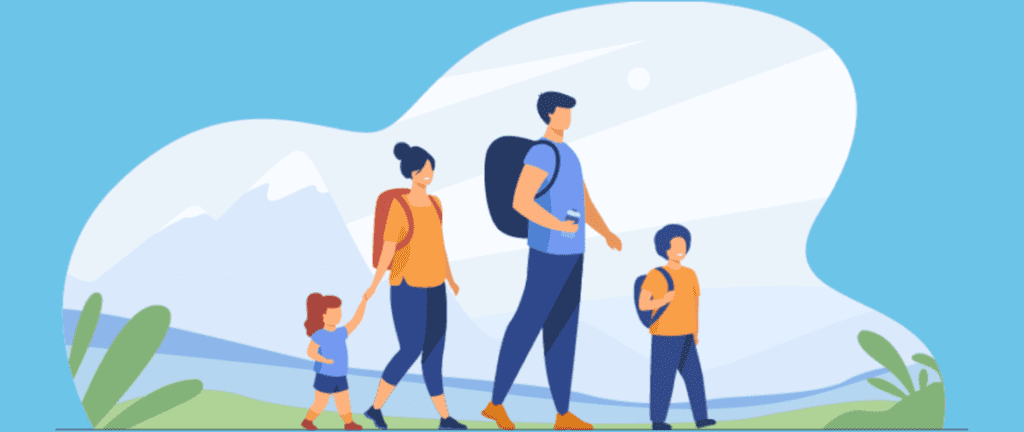Outdoor learning and wellbeing

As many schools across the world are reopening or preparing to reopen to more pupils – some settings are considering increasing outdoor learning in order to provide a safer learning environment where coronavirus is less likely to spread (Quian et al., 2020). However, spending more time outdoors is not only a useful strategy for limiting virus transmission, research suggests it may also be an important tool in supporting mental health – rebuilding students’ wellbeing, self regulation and resilience post-lockdown. A growing body of evidence suggests that spending more time outdoors in nature is beneficial for young people’s wellbeing (McCormick, 2017).
One issue with drawing conclusions from research reviews and meta-analyses on outdoor learning is that they cover such a broad field of approaches, including forest schooling, field work, gardening, residential visits and many more. Due to this diversityThe recognition of individual differences in terms of race, ethnicity, gender, sexual orientation, socio-economic status, physical ability, religious beliefs and other differences of approaches, studies use a range of measures to determine effects. In addition, studies are spread across a wide range of age groups, educational settings and subject areas (Fiennes et al., 2015), making it difficult to replicate findings, make comparisons and synthesise a coherent picture of the outdoor learning sector and its effectiveness as a whole. Some reviews have concluded that research needs to use more rigorous study designs and incorporate objective measures and experimental approaches in order to evidence statistically significant effects (Tillman et al., 2018).
However, some of the most robust cause and effect research within this field is that which evidences a relationship between nature and mental health, and nature and emotional regulation (Gill, 2011). A review of 15 correlational studies and 16 quasi-experimental studies found that exposure to nature has a statistically significant positive association to self-regulation in children (Weeland et al., 2019). Time spent in nature as a child has also been found to correlate with a reduced risk of psychiatric illness in later life (Engemann et al., 2019).
A longitudinal study involving over 40,000 pupils increased the amount of lessons taught outside in nature. 95 per cent of pupils reported that they enjoyed their lessons more when they were outdoors and 90 per cent said they felt healthier and happier. Importantly, teachers also experienced mental health gains. Seventy per cent of teachers said outdoor learning improved their job satisfaction and 72 per cent reported gains in health and wellbeing (Waite et al., 2016).
Some research suggests that vulnerable children including those from challenging backgrounds (McArdle et al., 2013), those who are perceived to be underachieving (Maynard et al., 2012) and those with challenging behaviour (Roe and Aspinall, 2011) may reap the greatest benefits from natural outdoor play and learning. Therefore spending more school time outside in nature could potentially also help narrow the gap that school closures are thought to have widened.
Key questions for you and colleagues
- Are there aspects of the school day which could take place outside in nature? If so, how could the impact on wellbeing be captured and reflected upon?
- Are there particular students who may benefit from increased time outdoors in nature? How could this form part of their support? Could it help narrow any gaps brought about by school closures?
References
Engemann K, Pedersen CB, Arge L, et al. (2019) Residential green space in childhood is associated with lower risk of psychiatric disorders from adolescence into adulthood. Proceedings of the National Academy of Sciences 116(11): 5188-5193.
Fiennes C, Oliver E, Dickson K, et al. (2015) The existing evidence-base about the effectiveness of outdoor learning. Available at: https://www.outdoor-learning.org/Portals/0/IOL%20Documents/Research/outdoor-learning-giving-evidence-revised-final-report-nov-2015-etc-v21.pdf?ver=2017-03-16-110244-937 (accessed 15 June 2020).
Gill T (2011) Children and nature: A quasi-systematic review of the empirical evidence. LSDC. Available at: https://www.london.gov.uk/sites/default/files/lsdc_-_sowing_the_seeds_-_literature_review_2011.pdf (accessed 15 June 2020).
Maynard T, Waters J and Clement J (2013) Child-initiated learning, the outdoor environment and the ‘underachieving’ child. Early Years 33(3): 212-225.
McArdle K, Harrison T and Harrison D (2013) Does a nurturing approach that uses an outdoor play environment build resilience in children from a challenging background? Journal of Adventure Education & Outdoor Learning 13(3): 238-254.
McCormick R (2017) Does access to green space impact the mental well-being of children: A systematic review. Journal of Pediatric Nursing 37: 3-7.
Qian H, Miao T, Li LIU, et al. (2020) Indoor transmission of SARS-CoV-2. MedRxiv. Epub ahead of print. DOI: 10.1101/2020.04.04.20053058.
Roe J and Aspinall P (2011) The restorative outcomes of forest school and conventional school in young people with good and poor behaviour. Urban Forestry and Urban Greening, 10(3): 205-212.
Tillmann S, Tobin D, Avison W, et al. (2018) Mental health benefits of interactions with nature in children and teenagers: A systematic review. Journal of Epidemiological Community Health 72(10), 958-966.
Waite S, B√∏lling M & Bentsen P (2015). Comparing apples and pears?: a conceptual framework for understanding forms of outdoor learning through comparison of English Forest Schools and Danish udeskole. Environmental Education Research, 22(6), 868-892
Waite S, Passy R, Gilchrist M, Hunt A, & Blackwell I (2016). Natural Connections Demonstration Project, 2012-2016. Natural Connections Demonstration Project, 2012-2016: Final Report.










